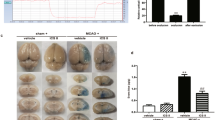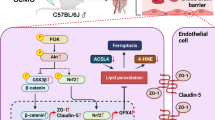Abstract
The dysfunction of blood-brain barrier (BBB) plays a pivotal role in brain injury and subsequent neurological deficits of ischemic stroke. The current study aimed to examine the potential correlation between p53 inhibition and the neuroprotective effect of on the BBB. Rat middle cerebral artery occlusion and reperfusion model (MCAO/R) and oxygen-glucose deprivation/re-oxygenation model (OGD/R) were employed to simulate cerebral ischemia-reperfusion (CI/R) injury occurrence in vivo and in vitro. mNSS and TTC staining were applied to evaluate neurological deficits and brain infarct volumes. Evans blue (EB) staining was carried out to examine the permeability of BBB. RT-qPCR and Western blot to examine the mRNA and protein levels. Cell viabilities were detected by CCK-8. Flow cytometry and ELISA assay were employed to examine apoptosis and neuroinflammation levels. TEER value and sodium fluorescein were carried out to explore the permeability of HBMEC cells. PFT-α inhibited P53 and promoted the expression of β-catenin and cyclin D1, which were reversed by DKK1. PFT-α inhibited neurological deficits, brain infarct volume, neuroinflammation, apoptosis, and BBB integrity than the MCAO/R rats; however, this inhibition was reversed by DKK1. PFT-α promoted OGD/R-induced cell viability in NSCs, and suppressed inflammation and apoptosis, but DKK1 weakened the effect of PFT-α. PFT-α increased OGD/R-induced TEER values in cerebrovascular endothelial cells, inhibited sodium fluorescein permeability, and increased the mRNA levels of tight junction protein, but they were all attenuated by DKK1. PFT-α protects the BBB after acute ischemic stroke via the Wnt/β-catenin pathway, which in turn improves neurological function.







Similar content being viewed by others
Data availability
All data generated or analyzed during this study are included in this article. Further enquiries can be directed to the corresponding author.
References
Beni FA, Kazemi M, Dianat-Moghadam H, Behjati M (2022) MicroRNAs regulating Wnt signaling pathway in colorectal cancer: biological implications and clinical potentials. Funct Integr Genomics 22:1073–1088. https://doi.org/10.1007/s10142-022-00908-x
Bortolasci CC, Spolding B, Kidnapillai S, Connor T, Truong TT, Liu ZS, Panizzutti B, Richardson MF, Gray L, Berk M, Dean OM (2020) Transcriptional effects of psychoactive drugs on genes involved in neurogenesis. Int J Mol Sci 21:8333. https://doi.org/10.3390/ijms21218333
Cao G, Jiang N, Hu Y, Zhang Y, Wang G, Yin M, Ma X, Zhou K, Qi J, Yu B, Kou J (2016) Ruscogenin attenuates cerebral ischemia-induced blood-brain barrier dysfunction by suppressing TXNIP/NLRP3 inflammasome activation and the MAPK pathway. Int J Mol Sci 17:1418. https://doi.org/10.3390/ijms17091418
Cappuccio I, Calderone A, Busceti CL, Biagioni F, Pontarelli F, Bruno V, Storto M, Terstappen GT, Gaviraghi G, Fornai F, Battaglia G (2005) Induction of Dickkopf-1, a negative modulator of the Wnt pathway, is required for the development of ischemic neuronal death. J Neurosci 25:2647–2657. https://doi.org/10.1523/JNEUROSCI.5230-04.2005
Chang J, Mancuso MR, Maier C, Liang X, Yuki K, Yang LU, Kwong JW, Wang J, Rao V, Vallon M, Kosinski C et al (2017) Gpr124 is essential for blood-brain barrier integrity in central nervous system disease. Nat Med 23:450–460. https://doi.org/10.1038/nm.4309
Chen C, Huang Y, Xia P, Zhang F, Li L, Wang E, Guo Q, Ye Z (2021a) Long noncoding RNA Meg3 mediates ferroptosis induced by oxygen and glucose deprivation combined with hyperglycemia in rat brain microvascular endothelial cells, through modulating the p53/GPX4 axis. Eur J Histochem 65. https://doi.org/10.4081/ejh.2021.3224
Chen F, Liu Z, Peng W, Gao Z, Ouyang H, Yan T et al (2018) Activation of EphA4 induced by EphrinA1 exacerbates disruption of the blood-brain barrier following cerebral ischemia-reperfusion via the Rho/ROCK signaling pathway. Exp Ther Med 16:2651–2658. https://doi.org/10.3892/etm.2018.6460
Chen W, Jiang L, Hu Y, Fang G, Yang B, Li J et al (2021b) Nanomedicines, an emerging therapeutic regimen for treatment of ischemic cerebral stroke: a review. J Control Release 340:342–360. https://doi.org/10.1016/j.jconrel.2021.10.020
Guo H, Fan Z, Wang S, Ma L, Wang J, Yu D et al (2021) Astrocytic A1/A2 paradigm participates in glycogen mobilization mediated neuroprotection on reperfusion injury after ischemic stroke. J Neuroinflammation 18:230. https://doi.org/10.1186/s12974-021-02284-y
Harati R, Hammad S, Tlili A, Mahfood M, Mabondzo A, Hamoudi R (2022) miR-27a-3p regulates expression of intercellular junctions at the brain endothelium and controls the endothelial barrier permeability. PLoS One 17:e0262152. https://doi.org/10.1371/journal.pone.0262152
Hong SA, Yoo SH, Lee HH, Sun S, Won HS, Kim O et al (2018) Prognostic value of Dickkopf-1 and ss-catenin expression in advanced gastric cancer. BMC Cancer 18:506. https://doi.org/10.1186/s12885-018-4420-8
Hou JB, Shen QN, Wan X, Liu XK, Yu Y, Li M et al (2021) Ubiquitin-specific protease 29 exacerbates cerebral ischemia-reperfusion injury in mice. Oxid Med Cell Longev 2021:6955628. https://doi.org/10.1155/2021/6955628
Huang P, Wan H, Shao C, Li C, Zhang L, He Y (2021) Recent advances in Chinese herbal medicine for cerebral ischemic reperfusion injury. Front Pharmacol 12:688596. https://doi.org/10.3389/fphar.2021.688596
Jiang H, Zhang Z, Yu Y, Chu HY, Yu S, Yao S et al (2022) Drug discovery of DKK1 inhibitors. Front Pharmacol 13:847387. https://doi.org/10.3389/fphar.2022.847387
Khamchai S, Chumboatong W, Hata J, Tocharus C, Suksamrarn A, Tocharus J (2022) Morin attenuated cerebral ischemia/reperfusion injury through promoting angiogenesis mediated by angiopoietin-1-Tie-2 axis and Wnt/beta-catenin pathway. Neurotox Res 40:14–25. https://doi.org/10.1007/s12640-021-00470-7
Kim NH, Kim HS, Kim NG, Lee I, Choi HS, Li XY et al (2011) p53 and microRNA-34 are suppressors of canonical Wnt signaling. Sci Signal 4:ra71. https://doi.org/10.1126/scisignal.2001744
Li J, Li B, Bu Y, Zhang H, Guo J, Hu J et al (2022a) Sertad1 induces neurological injury after ischemic stroke via the CDK4/p-Rb pathway. Mol Cells 45:216–230. https://doi.org/10.14348/molcells.2021.0071
Li SS, Hua XY, Zheng MX, Wu JJ, Ma ZZ, Xing XX et al (2022b) Electroacupuncture treatment improves motor function and neurological outcomes after cerebral ischemia/reperfusion injury. Neural Regen Res 17:1545–1555. https://doi.org/10.4103/1673-5374.330617
Lin Q, Ma Y, Chen Z, Hu J, Chen C, Fan Y et al (2020) Sestrin-2 regulates podocyte mitochondrial dysfunction and apoptosis under high-glucose conditions via AMPK. Int J Mol Med 45:1361–1372. https://doi.org/10.3892/ijmm.2020.4508
Liu B, Tang J, Li S, Zhang Y, Li Y, Dong X (2013) Involvement of the Wnt signaling pathway and cell apoptosis in the rat hippocampus following cerebral ischemia/reperfusion injury. Neural Regen Res 8:70–75. https://doi.org/10.3969/j.issn.1673-5374.2013.01.009
Liu D, Wang H, Zhang Y, Zhang Z (2020a) Protective effects of chlorogenic acid on cerebral ischemia/reperfusion injury rats by regulating oxidative stress-related Nrf2 pathway. Drug Des Devel Ther 14:51–60. https://doi.org/10.2147/DDDT.S228751
Liu Y, Wu X, Du D, Liu J, Zhang W, Gao Y et al (2021) p53 inhibition provides a pivotal protective effect against cerebral ischemia-reperfusion injury via the Wnt signaling pathway. Cerebrovasc Dis 50:682–690. https://doi.org/10.1159/000516889
Liu Y, Zhang J, Zan J, Zhang F, Liu G, Wu A (2020b) Lidocaine improves cerebral ischemia-reperfusion injury in rats through cAMP/PKA signaling pathway. Exp Ther Med 20:495–499. https://doi.org/10.3892/etm.2020.8688
Nakada-Honda N, Cui D, Matsuda S, Ikeda E (2021) Intravenous injection of cyclophilin A realizes the transient and reversible opening of barrier of neural vasculature through basigin in endothelial cells. Sci Rep 11:19391. https://doi.org/10.1038/s41598-021-98163-w
Nazarinia D, Sharifi M, Dolatshahi M, Nasseri Maleki S, Madani Neishaboori A, Aboutaleb N (2021) FoxO1 and Wnt/beta-catenin signaling pathway: molecular targets of human amniotic mesenchymal stem cells-derived conditioned medium (hAMSC-CM) in protection against cerebral ischemia/reperfusion injury. J Chem Neuroanat 112:101918. https://doi.org/10.1016/j.jchemneu.2021.101918
Pan J, Li X, Guo F, Yang Z, Zhang L, Yang C (2019) Ginkgetin attenuates cerebral ischemia-reperfusion induced autophagy and cell death via modulation of the NF-kappaB/p53 signaling pathway. Biosci Rep 39:BSR20191452. https://doi.org/10.1042/BSR20191452
Pandian J, Panneerpandian P, Sekar BT, Selvarasu K, Ganesan K (2022) OCT4-mediated transcription confers oncogenic advantage for a subset of gastric tumors with poor clinical outcome. Funct Integr Genomics 22:1345–1360. https://doi.org/10.1007/s10142-022-00894-0
Pu S, Jia C, Li Z, Zang Y (2022) Protective mechanism of proprotein convertase subtilisin-like kexin type 9 inhibitor on rats with middle cerebral artery occlusion-induced cerebral ischemic infarction. Comput Intell Neurosci 2022:4964262. https://doi.org/10.1155/2022/4964262
Qiao W, Zang Z, Li D, Shao S, Li Q, Liu Z (2023) Liensinine ameliorates ischemia-reperfusion-induced brain injury by inhibiting autophagy via PI3K/AKT signaling. Funct Integr Genomics 23:140. https://doi.org/10.1007/s10142-023-01063-7
Ren L, Chen H, Song J, Chen X, Lin C, Zhang X et al (2019) MiR-454-3p-Mediated Wnt/beta-catenin signaling antagonists suppression promotes breast cancer metastasis. Theranostics 9:449–465. https://doi.org/10.7150/thno.29055
Shen MH, Zhang CB, Zhang JH, Li PF (2016) Electroacupuncture attenuates cerebral ischemia and reperfusion injury in middle cerebral artery occlusion of rat via modulation of apoptosis, inflammation, oxidative stress, and excitotoxicity. Evid Based Complement Alternat Med 2016:9438650. https://doi.org/10.1155/2016/9438650
Shi Y, Yi Z, Zhao P, Xu Y, Pan P (2021) MicroRNA-532-5p protects against cerebral ischemia-reperfusion injury by directly targeting CXCL1. Aging (Albany NY) 13:11528–11541. https://doi.org/10.18632/aging.202846
Wan H, Yang Y, Li Z, Cheng L, Ding Z, Wan H et al (2021) Compatibility of ingredients of Danshen (Radix Salviae Miltiorrhizae) and Honghua (Flos Carthami) and their protective effects on cerebral ischemia-reperfusion injury in rats. Exp Ther Med 22:849. https://doi.org/10.3892/etm.2021.10281
Wen L, Liu L, Li J, Tong L, Zhang K, Zhang Q et al (2019) NDRG4 protects against cerebral ischemia injury by inhibiting p53-mediated apoptosis. Brain Res Bull 146:104–111. https://doi.org/10.1016/j.brainresbull.2018.12.010
Wisniewska MB (2013) Physiological role of beta-catenin/TCF signaling in neurons of the adult brain. Neurochem Res 38:1144–1155. https://doi.org/10.1007/s11064-013-0980-9
Xie J, Kittur FS, Li PA, Hung CY (2022) Rethinking the necessity of low glucose intervention for cerebral ischemia/reperfusion injury. Neural Regen Res 17:1397–1403. https://doi.org/10.4103/1673-5374.330592
Yang M, Sun Y, Xiao C, Ji K, Zhang M, He N et al (2019) Integrated analysis of the altered lncRNAs and mRNAs expression in 293T cells after ionizing radiation exposure. Int J Mol Sci 20:2968. https://doi.org/10.3390/ijms20122968
Zhang P, Lei X, Sun Y, Zhang H, Chang L, Li C et al (2016) Regenerative repair of Pifithrin-alpha in cerebral ischemia via VEGF dependent manner. Sci Rep 6:26295. https://doi.org/10.1038/srep26295
Zhang QG, Wang R, Khan M, Mahesh V, Brann DW (2008) Role of Dickkopf-1, an antagonist of the Wnt/beta-catenin signaling pathway, in estrogen-induced neuroprotection and attenuation of tau phosphorylation. J Neurosci 28:8430–8441. https://doi.org/10.1523/JNEUROSCI.2752-08.2008
Funding
This study was funded by the Natural Science Foundation of Shandong Province (No. ZR2020QH104) and Science and Technology Program of Binzhou Medical University (No. BY2018KJ06).
Author information
Authors and Affiliations
Contributions
HTZ, DYD, and XNG conceptualized and designed the study. XLT, YQX, and BW collected, organized, and drafted the information. All authors analyzed the data. HTZ, DYD, and XNG wrote the manuscript. SJY, PFL, and ZFL performed manuscript revision. All the authors have read and approved the manuscript.
Corresponding authors
Ethics declarations
Ethics approval
Animal care was conducted in compliance with the Guidelines for Care and Use of Laboratory Animals issued by the Ministry of Science and Technology of China, and the experimental protocols were passed by the Binzhou Medical University Hospital Animals Care and Use Committee. Every effort was made to reduce the number of animals as well as their suffering.
Informed consent
n/a
Consent for publication
n/a
Competing interests
The authors declare no competing interests.
Additional information
Publisher’s Note
Springer Nature remains neutral with regard to jurisdictional claims in published maps and institutional affiliations.
Supplementary information

ESM 1
Supplementary Figure 1 Diagram showing the experimental design of this study about the MCAO/R+PFT-α+DKK1 group, including the timing and number of rats for MACO/R, DKK1 treatment, PFT-α treatment, neurological deficit assessment, cerebral infarct volume, brain water content assessment, WB, RT-qPCR, ELISA assay. (PNG 397 kb)

ESM 2
Supplementary Figure 2 Diagram showing the experimental design of this study about the OGD/R+PFT-α+DKK1 group. A. The timing for detecting the effects of OGD/R, DKK1 and PFT-α on NSCs viability, apoptosis, inflammation and related signaling pathway proteins. B. The timing for detecting the effects of OGD/R, DKK1 and PFT-α on HBMECs permeability. (PNG 299 kb)
Rights and permissions
Springer Nature or its licensor (e.g. a society or other partner) holds exclusive rights to this article under a publishing agreement with the author(s) or other rightsholder(s); author self-archiving of the accepted manuscript version of this article is solely governed by the terms of such publishing agreement and applicable law.
About this article
Cite this article
Zhang, H., Du, D., Gao, X. et al. PFT-α protects the blood-brain barrier through the Wnt/β-catenin pathway after acute ischemic stroke. Funct Integr Genomics 23, 314 (2023). https://doi.org/10.1007/s10142-023-01237-3
Received:
Revised:
Accepted:
Published:
DOI: https://doi.org/10.1007/s10142-023-01237-3




